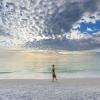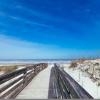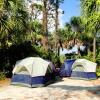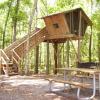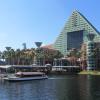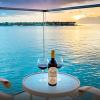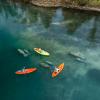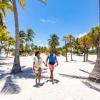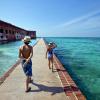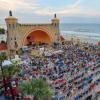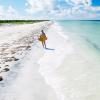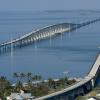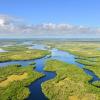We skimmed across the light chop on the surface as the sunlight sparkled on the wave tips like a million blinking stars. We kept our distance while admiring myriad ducks that seemed to enjoy landing, taking off and floating amid the islands of hyacinths and lilies.
Below our boat’s idling hull, hydrilla plants appeared as huge underwater cities, providing habitat and nurturing quarters for largemouth bass, bluegill, crappie and species darting about that we couldn’t identify in the shadowy depths.
On this glorious day, I was seated on a small bass-fishing boat on Lake Okeechobee with my fiance, her son and our guide, Bill Fleming.
“The diversity here is overwhelming,” proclaimed Bill, without a hint of exaggeration in his voice. He pointed out plants such as cattails, bulrush, willows, eelgrass and even multi-colored water lettuces. Frogs seemed to be crouched everywhere, but even so most undoubtedly missing our view due to the blending of their camouflaged skin.
I spotted a green water snake wrapped around a floating tree branch, bloated from no doubt an endless menu of frogs and salamanders. At times, we’d lock gazes with surfacing turtles and those sunning themselves atop flotsam, the creatures seemingly ever-ready to turn tail-up and scurry for the depths if our approach came in their direction.
We didn’t see any alligators during our four-hour tour, although Bill says their glowing eyes pinpoint resting places at night. He cautioned that alligators and, for that matter, all wildlife are to be admired but not approached.
Bill stopped at a location near Buckhead Ridge and the Okee-Tantie Recreation Area on the lake’s upper west side. We fished next to a dense forest of underwater hydrilla, our offerings including plastic worms and small spinner baits.
In about 30 minutes, we released three bass in the one- to three-pound range and five chunky bluegill. Before returning to the boat ramp, we admired herons, egrets and a variety of ducks and other waterfowl. The vibrancy and health of Lake Okeechobee totally impressed us.
Lake Okeechobee’s first inhabitants were Tequesta, Mayaimi and Calusa tribes in the 16th century. The Seminole Indians arrived in the 1700s and named it Okeechobee, meaning "big water." Known commonly by the moniker, “the Big O” is not only the largest lake in Florida, it’s the second-largest freshwater lake wholly within the continental United States at 35 miles long and 25 miles wide.
Lake Okeechobee delivers water into the Everglades ecosystem, and waterways on either side make it part of a 152-mile passageway from coast to coast known as the Okeechobee Waterway. Fairly shallow, with an average depth of 11 to 14 feet, the Big O serves as a major source of drinking water for lakeside towns and provides a reserve for the Sunshine State’s six million lower east coast residents.
The area boasts the distinction of being one of the most productive freshwater recreational fishing sport fisheries in North America with more than 60 species (largemouth bass being the biggest star). I’m told you can catch snook and tarpon – more typically saltwater gamesters – near the W.P. Franklin Lock and the St. Lucie Locks. In addition, more than six million annual visitors enjoy the 38 recreation areas to go boating, sightseeing, camping, hiking, biking and horseback riding.
You simply have to take in a lunch at one of the rustic restaurants surrounding the lake and order the fried catfish – a local delicacy. It’s absolutely delicious, especially served with hushpuppies and washed down with sweet iced tea. Some even offer an “all-you-can-eat” special.
On the following day, we decided to do a hike on part of the Lake Okeechobee Scenic Trail (LOST).
Since 1983, 110 miles of the Herbert Hoover Dike around Lake Okeechobee – unpaved and typically double-track gravel – have been included in the Florida National Scenic Trail. LOST circles the Big O atop the 35-foot dike, providing elevated views of the lake. Fellow hikers told us about seeing manatees, deer and wild hogs – we didn’t encounter those, but did admire alligators on the shoreline and an osprey circling overhead. We lost count of the species of birds, the colorful plantlife and native trees.
Lake Okeechobee’s surrounding dike, built by the U.S. Army Corps of Engineers (COE), is dotted with five boat ramps along the waterway: the St. Lucie South Recreation Area, Ortona North Recreation Area, W.P. Franklin South Recreation Area, W.P. Franklin North Campground and Port Mayaca.
A number of interesting archaeological finds have taken place over the years. On the southwestern shore near Fisheating Creek, a complex of circular mounds built about 2,000 years ago, possibly by Calusa Indians was found.
Other artifacts around the lake symbolize wildlife in those days, such as carved wooden birds, panthers and owls. Near Belle Glade, a mound excavated in 1933, turned up small totem poles, hair pins carved from deer bones, daggers fashioned from the jaws of alligators and even a bowl made from a human skull.
Recently, the Okeechobee Battlefield State Park moved from private to public ownership; although, the park is not yet open to the public. The Battle of Lake Okeechobee on Christmas Day in 1837 occurred on the northeast shores of the lake between the U.S. Army under (among others) Colonel Zachary Taylor – a future President – and Creek and Miccosukee Indians. It became the largest of the three Seminole Wars fought in Florida. Some of the tribe members survived and their ancestors have emerged as a vibrant and important group of Florida’s history and culture.
Admiring the Old South
Notable goings-on in the area that cannot be overlooked: LaBelle's famous Swamp Cabbage Festival the last weekend of February. LaBelle is in Hendry County at the southwest corner of Lake Okeechobee. You can also take in the Hendry County Fair & Livestock Show in February and the Clewiston Sugar Festival in April. I also love driving through the county’s picturesque rural communities of LaBelle and Felda.
Okaloacoochee Slough State Forest, one of the largest in south Florida, is south of LaBelle on County Road 832. The pre-Columbian landscape encompasses over 32,000 acres and was logged in the early 1900s before becoming a cattle ranch. It was later purchased by the state. It’s hereabouts where one might have the best chance of glimpsing the rare Florida panther. More common are sightings of black bears, sandhill cranes, wood storks and gopher tortoises.
My favorite place around Lake Okeechobee is Clewiston. Situated on the lake's southern shore, it packs tremendous Old South appeal – don’t miss the interesting Sugarland Express tour of a local farm and mill.
I’d also recommend visiting the Big Cypress Seminole Indian Reservation, the largest Seminole Indian community. A second smaller community is the Brighton Indian Reservation in Glades County, on the western side of Lake Okeechobee.
The Seminoles invite the public to visit their reservations and provide gambling facilities, restaurants, overnight accommodations, and hunting and fishing trips. Visitors can learn more about native culture at the fascinating Ah-Tah-Thi-Ki Museum. Sample alligator nuggets, frog legs, catfish or yummy frybread at the Swamp Water Café, take an airboat ride to an Indian camp and maybe catch a glimpse of a Florida panther at the Billie Swamp Safari.
You can also access the Lake Okeechobee Scenic Trail from the town of Okeechobee at the lake's north end. Here I once stayed in a campground on the Kissimmee River, during which time I rode a pontoon boat out of the marina and onto the lake. This took place during the town’s celebration of its fishing and farming legacy with an annual Speckled Perch Festival and Okeechobee Cattlemen's Spring Rodeo, which takes place in March. There is also a Labor Day rodeo.
If you’ve never ridden upon a swamp buggy, this is a good place to do it: the nearby Kissimmee Prairie Preserve State Park permits visitors to take a swamp buggy tour and get closer to the local flora and fauna.
Places to stay range from the quaint to quite nice, such as the Lakeview Inn & Suites, the Okeechobee Resort KOA or the Okee-Tantie Campground & Marina. Many motels, lodges, resorts and campgrounds provide kayak and canoe rentals, guided fishing and hunting trips during season, guided trail hikes and sightseeing tours.
Plan your trip accordingly to take in as much of this unique area as possible. By doing so, you’ll develop the deep appreciation that I and so many others have about Lake Okeechobee – a fantastic place to enjoy friendly southern hospitality, eat heaps of delicious fried catfish, get out on the lake in a boat or canoe to admire the wildlife scene not obvious from the shoreline, and appreciate this historic body of water that’s meant so much to the history and development of Florida.
